Exploring Factors Behind Weekday and Weekend Variations in Public Space Vitality in Traditional Villages, Using Wi-Fi Sensing Method
Abstract
1. Introduction
2. Literature Review
2.1. Public Space Vitality in Traditional Villages
2.2. Assessment of Public Space Vitality in Settlements
2.3. Wi-Fi Sensing Method Used in Related Studies
2.4. Impact Factors of Public Space Vitality in Settlements
2.5. Research Aims
3. Materials and Methods
3.1. Study Area
3.2. Research Framework
3.3. Identification of Typical Time Periods
3.4. Calculation and Data Collection Methods for Vitality During Typical Time Periods
3.5. Selection of Impact Factor Indicators and Calculation Methods
3.6. Methods for Analyzing Impact Factors
3.6.1. Model Selection
3.6.2. Methods for Regression Modeling and Influence Strength Comparison
4. Results
4.1. Spatio-Temporal Dynamics of Public Space Vitality
4.1.1. Spatial Dynamics of Public Space Vitality
4.1.2. Temporal Dynamics of Public Space Vitality
4.2. Correlation Analysis of Impact Factors
4.3. Regression Analysis of Impact Factors
4.3.1. Regression Model for Weekday Morning Peak
4.3.2. Regression Model for Weekday Midday Off-Peak
4.3.3. Regression Model for Weekend Morning Peak
4.3.4. Regression Model for Weekend Midday Off-Peak
4.4. Time-Varying Influence Strength of Key Factors
4.4.1. Internal Dimension
4.4.2. External Dimension
5. Discussion
5.1. Key Findings and Management Implications
5.2. Design-Oriented Application of Research Findings
5.3. Advantages of Wi-Fi Sensing Method
5.4. The Influence of Residents on Public Space Vitality in Traditional Villages
5.5. Limitations and Research Prospects
6. Conclusions
Author Contributions
Funding
Data Availability Statement
Conflicts of Interest
Appendix A
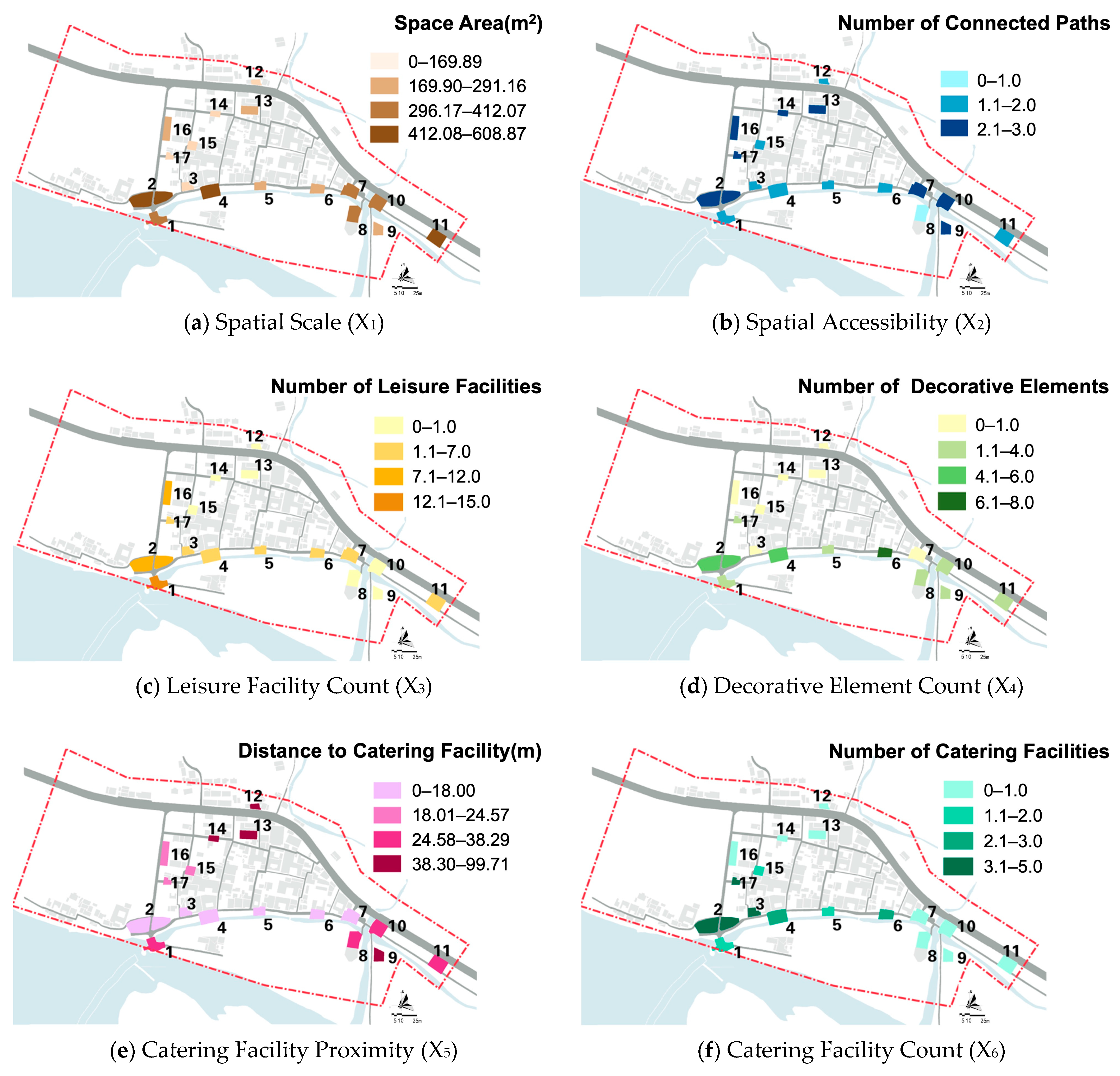

References
- Zhang, H.; Chen, J.; Zhou, C. Research Review and Prospects of Traditional Villages in China. City Plan. Rev. 2017, 41, 74–80. [Google Scholar]
- Li, B.; Luo, Q.; Liu, P.; Zhang, J. Knowledge Maps Analysis of Traditional Villages Research in China Based on the Citespace Method. Econ. Geogr. 2017, 37, 207–214. [Google Scholar]
- Menon, A.G.K.; Nigam, N. Smart heritage villages: Lessons from Indian initiatives. J. Cult. Herit. Manag. Sustain. Dev. 2021, 11, 445–460. [Google Scholar] [CrossRef]
- Cai, G.; Xu, L.; Gao, W.; Hong, Y.; Ying, X.; Wang, Y.; Qian, F. The Positive Impacts of Exhibition-Driven Tourism on Sustainable Tourism, Economics, and Population: The Case of the Echigo–Tsumari Art Triennale in Japan. Int. J. Environ. Res. Public Health 2020, 17, 1489. [Google Scholar] [CrossRef]
- The State Council of the People’s Republic of China. Comprehensive Rural Revitalization Plan (2024–2027). Available online: https://www.gov.cn/zhengce/202501/content_7000493.htm (accessed on 1 July 2025).
- General Office of the State Council. Opinions on Strengthening the Protection and Inheritance of Historical and Cultural Heritage in Urban and Rural Construction. Available online: https://www.gov.cn/zhengce/2021-09/03/content_5635308.htm (accessed on 1 July 2025).
- Dilixiati, D.; Bell, S. The Use of Public Spaces in Traditional Residential Areas After Tourism-Oriented Renovation: A Case Study of Liu Xing Street in Yining, China. Land 2025, 14, 1041. [Google Scholar] [CrossRef]
- Jacobs, J. The Death and Life of Great American Cities; Penguin Random House: New York, NY, USA, 1961. [Google Scholar]
- Lynch, K. Good City Form; The MIT Press: Cambridge, MA, USA, 1984. [Google Scholar]
- Bentley, I. Responsive Environments: A Manual for Designers; Routledge: London, UK, 1985. [Google Scholar]
- Gehl, J. Life Between Buildings; Danish Architectural Press: Copenhagen, Denmark, 2008. [Google Scholar]
- Lavrusheva, O. The Concept of Vitality: Review of the Vitality-Related Research Domain. New Ideas Psychol. 2020, 56, 100752. [Google Scholar] [CrossRef]
- Etuk, L.; Keen, M.; Wall, C. The Factors Associated with Rural Community Success: A Review of Rural Community Vitality Research; Oregon State University: Corvallis, OR, USA, 2012. [Google Scholar]
- Hu, Y.; Chen, S.; Cao, W.; Cao, C. The Concept and Cultural Connotation of Traditional Villages. Urban Dev. Stud. 2014, 21, 10–13. [Google Scholar]
- Jalaladdini, S.; Oktay, D. Urban Public Spaces and Vitality: A Socio-Spatial Analysis in the Streets of Cypriot Towns. Procedia Soc. Behav. Sci. 2012, 35, 664–674. [Google Scholar] [CrossRef]
- Hikmah; Nday, R.U.; Manu, A.K. Vitality of Public Open Space (Case Study: Taman Nostalgia Kupang). Mediterr. J. Soc. Sci. 2017, 8, 125–132. [Google Scholar] [CrossRef]
- Zagroba, M.; Szczepańska, A.; Senetra, A. Analysis and Evaluation of Historical Public Spaces in Small Towns in the Polish Region of Warmia. Sustainability 2020, 12, 8356. [Google Scholar] [CrossRef]
- Zumelzu, A.; Barrientos-Trinanes, M. Analysis of the Effects of Urban Form on Neighborhood Vitality: Five Cases in Valdivia, Southern Chile. J. Hous. Built Environ. 2019, 34, 897–925. [Google Scholar] [CrossRef]
- Ding, J.; Gao, Z.; Ma, S. Understanding Social Spaces in Tourist Villages through Space Syntax Analysis: Cases of Villages in Huizhou, China. Sustainability 2022, 14, 12376. [Google Scholar] [CrossRef]
- Zhang, Y.; Han, Y. Vitality Evaluation of Historical and Cultural Districts Based on the Values Dimension: Districts in Beijing City, China. Herit. Sci. 2022, 10, 137. [Google Scholar] [CrossRef]
- Song, J.; Zhu, Y.; Chu, X.; Yang, X. Research on the Vitality of Public Spaces in Tourist Villages through Social Network Analysis: A Case Study of Mochou Village in Hubei, China. Land 2024, 13, 359. [Google Scholar] [CrossRef]
- Hägerstrand, T. What about People in Regional Science. Pap. Reg. Sci. 1970, 24, 7–24. [Google Scholar] [CrossRef]
- Stokols, D. Environmental Psychology. Annu. Rev. Psychol. 1978, 29, 253–295. [Google Scholar] [CrossRef]
- Goffman, E. Behavior in Public Places: Notes on the Social Organization of Gatherings, 4th ed.; Free Press: New York, NY, USA, 1969. [Google Scholar]
- Long, Y.; Zhang, E. Insights/Opinion: Promoting Urban Studies and Practice with Emerging Technologies: City Laboratory, New City, and Future City Exploration. Int. J. Smart Sustain. Cities 2024, 2371004. [Google Scholar] [CrossRef]
- Lou, G.; Chen, Q.; Chen, W. Strategic Planning for Sustainable Urban Park Vitality: Spatiotemporal Typologies and Land Use Implications in Hangzhou’s Gongshu District via Multi-Source Big Data. Land 2025, 14, 1338. [Google Scholar] [CrossRef]
- Liu, S.; Lai, S.Q.; Liu, C.; Jiang, L. What Influenced the Vitality of the Waterfront Open Space? A Case Study of Huangpu River in Shanghai, China. Cities 2021, 114, 103197. [Google Scholar] [CrossRef]
- Long, Y.; Zhang, E. City Laboratory: Embracing New Data, New Elements, and New Pathways to Invent New Cities. Environ. Plan. B Urban Anal. City Sci. 2024, 51, 1068–1072. [Google Scholar] [CrossRef]
- Saputra, A.A.; Surjono, S.; Meidiana, C. Vitality of Giri Kedaton Site as a Religious Tourism Attraction in Sidomukti Village, Kebomas, Gresik. J. Indones. Tour. Dev. Stud. 2015, 3, 93–104. [Google Scholar] [CrossRef][Green Version]
- Wu, J.; Lu, Y.; Gao, H.; Wang, M. Cultivating Historical Heritage Area Vitality Using Urban Morphology Approach Based on Big Data and Machine Learning. Comput. Environ. Urban Syst. 2022, 91, 101716. [Google Scholar] [CrossRef]
- Rastegar, N.; Ahmadi, M.; Malek, M. Factors Affecting the Vitality of Streets in Downtown Johor Bahru City. Indian J. Sci. Res. 2014, 7, 361–374. [Google Scholar]
- Zheng, J.; Bai, X.; Na, L.; Wang, H. Tourists’ Spatial–Temporal Behavior Patterns Analysis Based on Multi-Source Data for Smart Scenic Spots: Case Study of Zhongshan Botanical Garden, China. Processes 2022, 10, 181. [Google Scholar] [CrossRef]
- Gea-García, G.M.; Fernández-Vicente, C.; Barón-López, F.J.; Miranda-Páez, J. The Recreational Trail of the El Caminito del Rey Natural Tourist Attraction, Spain: Determination of Hikers’ Flow. Int. J. Environ. Res. Public Health 2021, 18, 1809. [Google Scholar] [CrossRef]
- Angel, A.; Cohen, A.; Dalyot, S.; Plaut, P. Estimating Pedestrian Traffic with Bluetooth Sensor Technology. Geo-Spat. Inf. Sci. 2023, 27, 1391–1404. [Google Scholar] [CrossRef]
- Traunmueller, M.W.; Johnson, N.; Malik, A.; Kontokosta, C.E. Digital Footprints: Using WiFi Probe and Locational Data to Analyze Human Mobility Trajectories in Cities. Comput. Environ. Urban Syst. 2018, 72, 4–12. [Google Scholar] [CrossRef]
- Li, L.; Chen, X.; Zhang, L.; Li, Q.; Yang, Y.; Chen, J. Space–time tourist flow patterns in community-based tourism: An application of the empirical orthogonal function to Wi-Fi data. Curr. Issues Tour. 2023, 26, 3004–3022. [Google Scholar] [CrossRef]
- Hu, X.; Shen, P.; Shi, Y.; Zhang, Z. Using Wi-Fi Probe and Location Data to Analyze the Human Distribution Characteristics of Green Spaces: A Case Study of the Yanfu Greenland Park, China. Urban For. Urban Green. 2020, 54, 126733. [Google Scholar] [CrossRef]
- Zhou, G.; Kurauchi, F.; Ito, S.; Du, R. Identifying Golden Routes in Tourist Areas Based on AMP Collectors. Asian Transp. Stud. 2022, 8, 100052. [Google Scholar] [CrossRef]
- Abedi, N.; Bhaskar, A.; Chung, E. Tracking Spatio-Temporal Movement of Human in Terms of Space Utilization Using Media-Access-Control Address Data. Appl. Geogr. 2014, 51, 72–81. [Google Scholar] [CrossRef]
- Li, J.; Sharma, A.; Mishra, D.; Davis, J.G.; Seneviratne, A. WiFi Sensing for Outdoor Surveillance. In Proceedings of the 2023 57th Asilomar Conference on Signals, Systems, and Computers, Pacific Grove, CA, USA, 29 October 2023; IEEE: Piscataway, NJ, USA, 2023; pp. 1713–1718. [Google Scholar]
- Wu, Z.; Lu, C.; Zhao, Y.; Xie, J.; Zou, D.; Su, X. The Protection of User Preference Privacy in Personalized Information Retrieval: Challenges and Overviews. Libri 2021, 71, 227–237. [Google Scholar] [CrossRef]
- Alam, S.S.; Al-Qurishi, M.; Souissi, R. Estimating Indoor Crowd Density and Movement Behavior Using WiFi Sensing. Front. Internet Things 2022, 1, 967034. [Google Scholar] [CrossRef]
- Bačić, D.; Braun, A. Public Open Spaces in Historical Context: Croatian Examples in-between Ambition and Restraint. In Proceedings of the Re-Evaluating Contemporary Designs in Historical Context, Istanbul, Turkey, 22–24 July 2015; pp. 65–75. [Google Scholar]
- Lee, S.; Cho, N. Nonlinear and Interaction Effects of Multi-Dimensional Street-Level Built Environment Features on Urban Vitality in Seoul. Cities 2025, 165, 106145. [Google Scholar] [CrossRef]
- Bi, S.; Du, J.; Tian, Z.; Zhang, Y. Investigating the Spatial Distribution Mechanisms of Traditional Villages from the Human Geography Region: A Case Study of Jiangnan, China. Ecol. Inform. 2024, 81, 102649. [Google Scholar] [CrossRef]
- Zhang, W.; Yang, H. Quantitative Research of Traditional Village Morphology Based on Spatial Genes: A Case Study of Shaanxi Province, China. Sustainability 2024, 16, 9003. [Google Scholar] [CrossRef]
- Chang, H.; Xiong, K.; Zhu, D.; Zhang, Z.; Zhang, W. Ecosystem Services Value Realization and Ecological Industry Design in Scenic Areas of Karst in South China. Forests 2024, 15, 363. [Google Scholar] [CrossRef]
- Nie, Z.; Chen, C.; Pan, W.; Dong, T. Exploring the Dynamic Cultural Driving Factors Underlying the Regional Spatial Pattern of Chinese Traditional Villages. Buildings 2023, 13, 3068. [Google Scholar] [CrossRef]
- Wang, K.; Ja`afar, N.H.B.; Mohammad, N.B.; Malek, M.I.B.A. To Evaluate the Value of Traditional Village Landscape Elements in Influencing the Huizhou Character of the UNESCO World Heritage Site: A Case Study of Huizhou, Anhui, China. Int. J. Relig. 2024, 5, 4195–4212. [Google Scholar] [CrossRef]
- Dakhiya, C.; Landysh, M.; Lada, R. Event Tourism: The Experience of Involving the Intangible Cultural Heritage of the Republic of Tatarstan in Tourism. Serv. Tour. Curr. Chall. 2016, 10, 79–85. [Google Scholar] [CrossRef]
- Liu, C.; Qin, Y.; Wang, Y.; Yu, Y.; Li, G. Spatio-Temporal Distribution of Tourism Flows and Network Analysis of Traditional Villages in Western Hunan. Sustainability 2022, 14, 7943. [Google Scholar] [CrossRef]
- Ilieva, L.; Bozhinova, M.; Todorova, L.; Marinov, M.; Ismailov, T.; Spasova, S. Festivals: An Opportunity for Sustainable Development of Tourism Regions. Rev. Gest. Soc. Ambient. 2024, 18, e09356. [Google Scholar] [CrossRef]
- Akhundova, A. Role of Festivals in Stimulating the Development of Event Tourism. Theor. Pract. Res. Econ. Fields 2024, 15, 277. [Google Scholar] [CrossRef] [PubMed]
- Kang, C.D. Effects of the Human and Built Environment on Neighborhood Vitality: Evidence from Seoul, Korea, Using Mobile Phone Data. J. Urban Plan. Dev. 2020, 146, 05020024. [Google Scholar] [CrossRef]
- Mu, B.; Liu, C.; Mu, T.; Xu, X.; Tian, G.; Zhang, Y.; Kim, G. Spatiotemporal Fluctuations in Urban Park Spatial Vitality Determined by On-Site Observation and Behavior Mapping: A Case Study of Three Parks in Zhengzhou City, China. Urban For. Urban Green. 2021, 64, 127246. [Google Scholar] [CrossRef]
- Liu, J.; Li, Y.; Xu, Y.; Zhuang, C.C.; Hu, Y.; Yu, Y. Impacts of Built Environment on Urban Vitality in Cultural Districts: A Case Study of Haikou and Suzhou. Land 2024, 13, 840. [Google Scholar] [CrossRef]
- Li, M.; Liu, J.; Lin, Y.; Xiao, L.; Zhou, J. Revitalizing Historic Districts: Identifying Built Environment Predictors for Street Vibrancy Based on Urban Sensor Data. Cities 2021, 117, 103305. [Google Scholar] [CrossRef]
- Yang, C.; Lo, S.M.; Ma, R.; Fang, H. The Effect of the Perceptible Built Environment on Pedestrians’ Walking Behaviors in Commercial Districts: Evidence from Hong Kong. Environ. Plan. B Urban Anal. City Sci. 2024, 51, 329–346. [Google Scholar] [CrossRef]
- Chen, L.; Yan, S. Study on the Vitality of Public Space in Beautiful Villages and the Influencing Factors. Shanxi Archit. 2023, 49, 52–57. [Google Scholar] [CrossRef]
- Chen, Y.; Li, R. Spatial Distribution and Type Division of Traditional Villages in Zhejiang Province. Sustainability 2024, 16, 5262. [Google Scholar] [CrossRef]
- Gong, J.; Jian, Y.; Chen, W.; Liu, Y.; Hu, Y. Transitions in Rural Settlements and Implications for Rural Revitalization in Guangdong Province. J. Rural Stud. 2022, 93, 359–366. [Google Scholar] [CrossRef]
- Bian, J.; Chen, W.; Zeng, J. Spatial Distribution Characteristics and Influencing Factors of Traditional Villages in China. Int. J. Environ. Res. Public Health 2022, 19, 4627. [Google Scholar] [CrossRef] [PubMed]
- Wang, F.; Zhao, X.; Qiu, Y.; Luo, J. Adaptability of Traditional Villages as Tourist Destinations in Yellow River Basin, China. Indoor Built Environ. 2022, 32, 574–589. [Google Scholar] [CrossRef]
- Zhang, Z.H.; Yi, Y.; Sun, J.N. Entropy Method for Determination of Weight of Evaluating Indicators in Fuzzy Synthetic Evaluation for Water Quality Assessment. J. Environ. Sci. 2006, 18, 4. [Google Scholar] [CrossRef] [PubMed]
- Liu, S.; Zhu, Z.; Gao, Y.; Wang, S. Assessing the Dynamic Vitality of Public Spaces in Tourism-Oriented Traditional Villages: A Collaborative Active Perception Method. Herit. Sci. 2024, 12, 346. [Google Scholar] [CrossRef]
- Wen, Q.; Li, J.; Ding, J.; Wang, J. Evolutionary Process and Mechanism of Population Hollowing Out in Rural Villages in the Farming-Pastoral Ecotone of Northern China: A Case Study of Yanchi County, Ningxia. Land Use Policy 2023, 125, 106506. [Google Scholar] [CrossRef]
- Petre, A.-C.; Chilipirea, C.; Baratchi, M.; Dobre, C.; van Steen, M. WiFi Tracking of Pedestrian Behavior. In Smart Sensors Networks; Academic Press: Cambridge, MA, USA, 2017; pp. 309–337. ISBN 978-0-12-809859-2. [Google Scholar]
- Huang, J.; Hu, X.; Wang, J.; Lu, A. How Diversity and Accessibility Affect Street Vitality in Historic Districts? Land 2023, 12, 219. [Google Scholar] [CrossRef]
- Zhang, F.; Liu, Q.; Zhou, X. Vitality Evaluation of Public Spaces in Historical and Cultural Blocks Based on Multi-Source Data, a Case Study of Suzhou Changmen. Sustainability 2022, 14, 14040. [Google Scholar] [CrossRef]
- Fu, J.-M.; Tang, Y.-F.; Zeng, Y.-K.; Feng, L.-Y.; Wu, Z.-G. Sustainable Historic Districts: Vitality Analysis and Optimization Based on Space Syntax. Buildings 2025, 15, 657. [Google Scholar] [CrossRef]
- Vidal, D.G.; Teixeira, C.P.; Fernandes, C.O.; Olszewska-Guizzo, A.; Dias, R.C.; Vilaça, H.; Barros, N.; Maia, R.L. Patterns of Human Behaviour in Public Urban Green Spaces: On the Influence of Users’ Profiles, Surrounding Environment, and Space Design. Urban For. Urban Green. 2022, 74, 127668. [Google Scholar] [CrossRef]
- Zhang, J.; Hu, X.; Wang, J. Spatial Vitality Variation in Community Parks and Their Influencing Factors. PLoS ONE 2025, 20, e0312941. [Google Scholar] [CrossRef] [PubMed]
- Shao, L.; Ma, P.; Zhou, Z. Research on the Impact of Landscape Planning on Visual and Spatial Perception in Historical District Tourism: A Case Study of Laomendong. Land 2024, 13, 1134. [Google Scholar] [CrossRef]
- Zhou, M.; Yang, J. Geospatial Spatiotemporal Analysis of Tourism Facility Attractiveness and Tourism Vitality in Historic Districts: A Case Study of Suzhou Old City. Land 2025, 14, 922. [Google Scholar] [CrossRef]
- Zheng, G.; Ding, L.; Zheng, J. A Multi-Dimensional Evaluation of Street Vitality in a Historic Neighborhood Using Multi-Source Geo-Data: A Case Study of Shuitingmen, Quzhou. ISPRS Int. J. Geo-Inf. 2025, 14, 240. [Google Scholar] [CrossRef]
- Ye, Y.; Li, D.; Liu, X. How Block Density and Typology Affect Urban Vitality: An Exploratory Analysis in Shenzhen, China. Urban Geogr. 2017, 39, 631–652. [Google Scholar] [CrossRef]
- Huang, X.; Gong, P.; Wang, S.; White, M.; Zhang, B. Machine Learning Modeling of Vitality Characteristics in Historical Preservation Zones with Multi-Source Data. Buildings 2022, 12, 1978. [Google Scholar] [CrossRef]
- Zheng, J.; He, J.; Tang, H. The Vitality of Public Space and the Effects of Environmental Factors in Chinese Suburban Rural Communities Based on Tourists and Residents. Int. J. Environ. Res. Public Health 2023, 20, 263. [Google Scholar] [CrossRef]
- Ren, K.; Xu, J. Formation Process and Spatial Representation of Tourist Destination Personality from the Perspective of Cultural Heritage: Application in Traditional Villages in Ancient Huizhou, China. Land 2024, 13, 423. [Google Scholar] [CrossRef]
- Ding, Z.; Han, X. Optimization Design of Public Space in Huizhou Traditional Villages: Taking Qinghua Town as an Example. Front. Humanit. Soc. Sci. 2024, 4, 472–478. [Google Scholar] [CrossRef]
- Zhou, J.; Hou, Q.; Dong, W. Spatial Characteristics of Population Activities in Suburban Villages Based on Cellphone Signaling Analysis. Sustainability 2019, 11, 2159. [Google Scholar] [CrossRef]
- Ghahramani, M.; Zhou, M.; Wang, G. Urban Sensing Based on Mobile Phone Data: Approaches, Applications, and Challenges. IEEE/CAA J. Autom. Sin. 2020, 7, 627–637. [Google Scholar] [CrossRef]
- Svečko, J.; Malajner, M.; Gleich, D. Distance Estimation Using RSSI and Particle Filter. ISA Trans. 2015, 55, 275–285. [Google Scholar] [CrossRef]
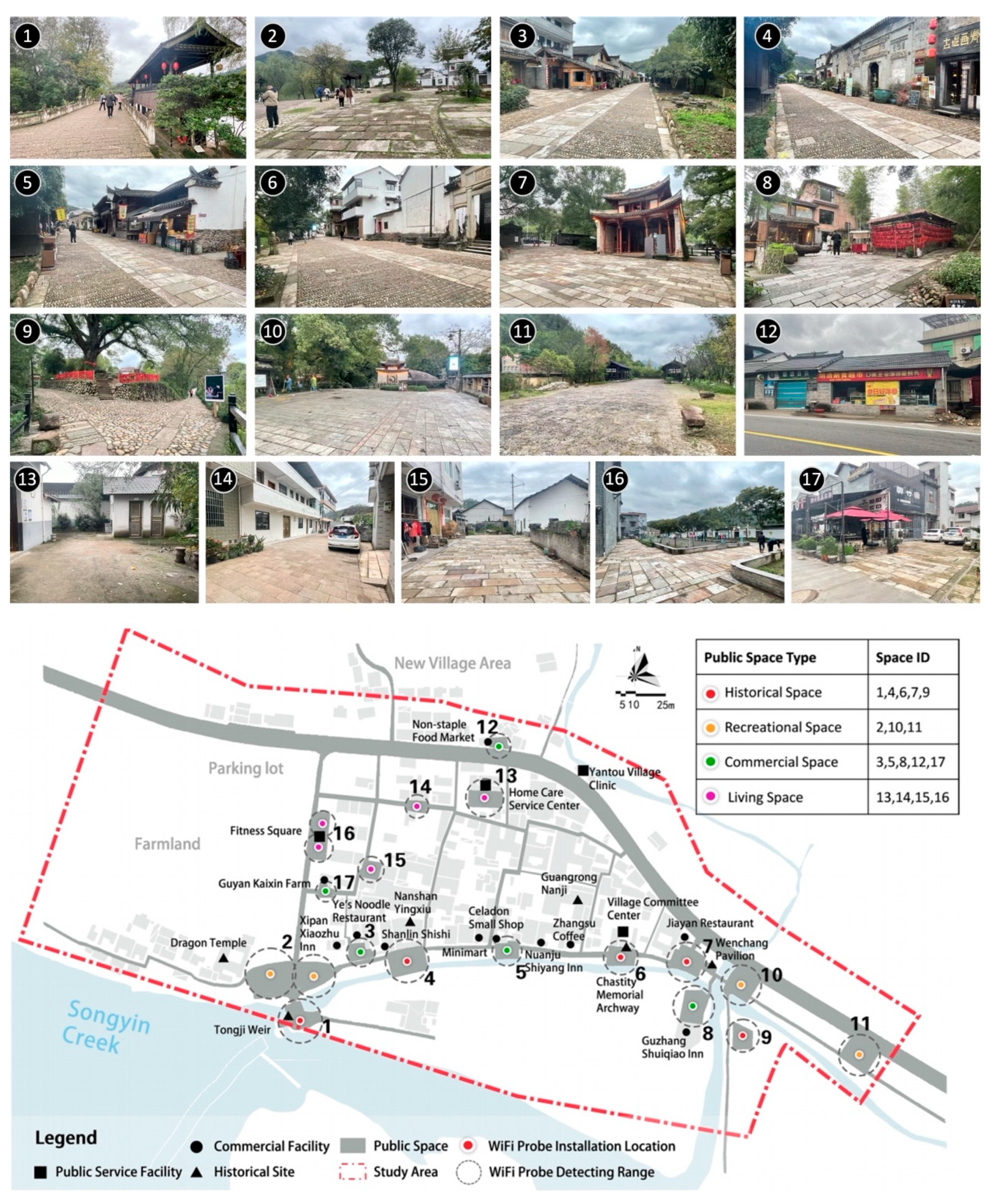
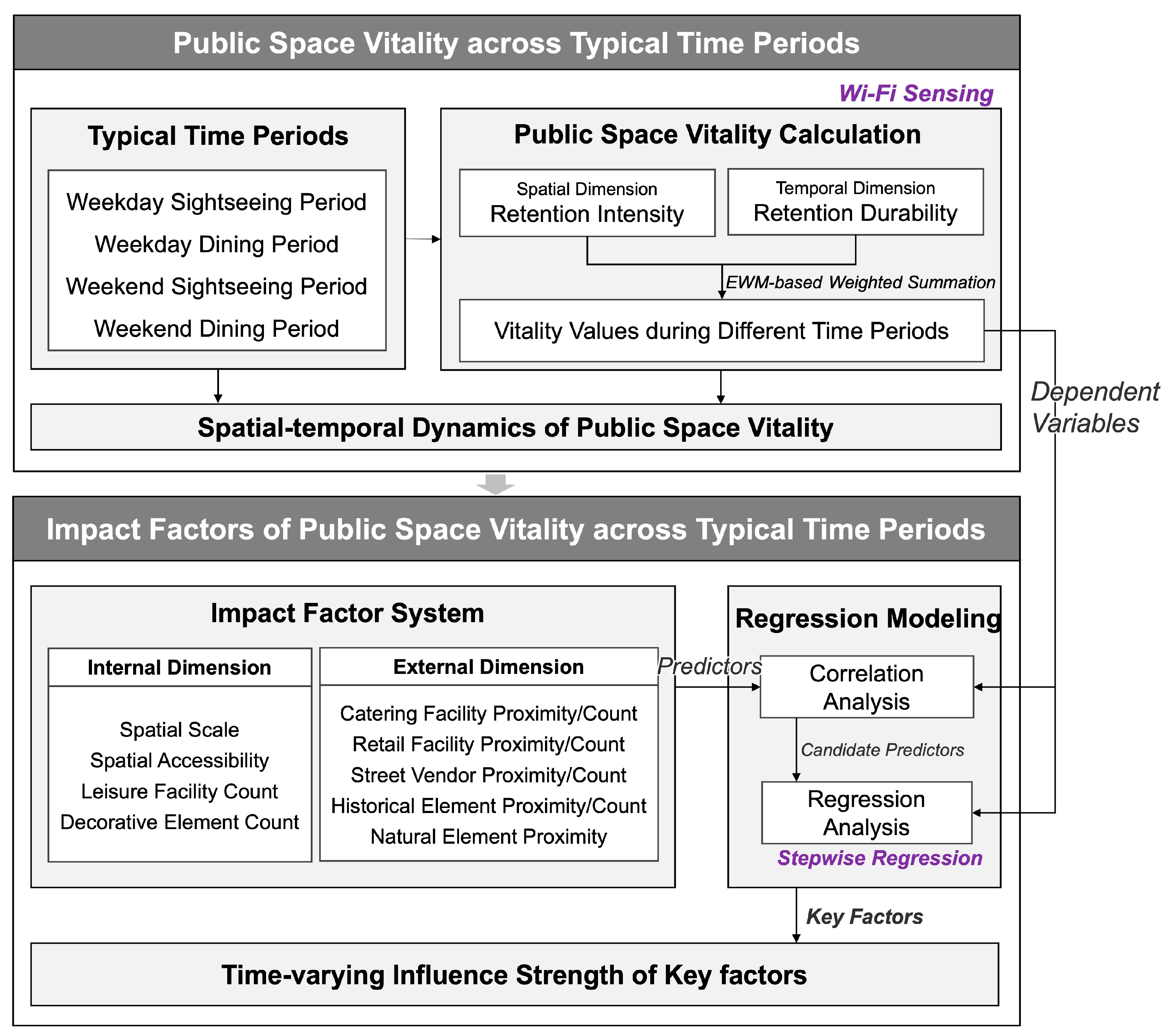
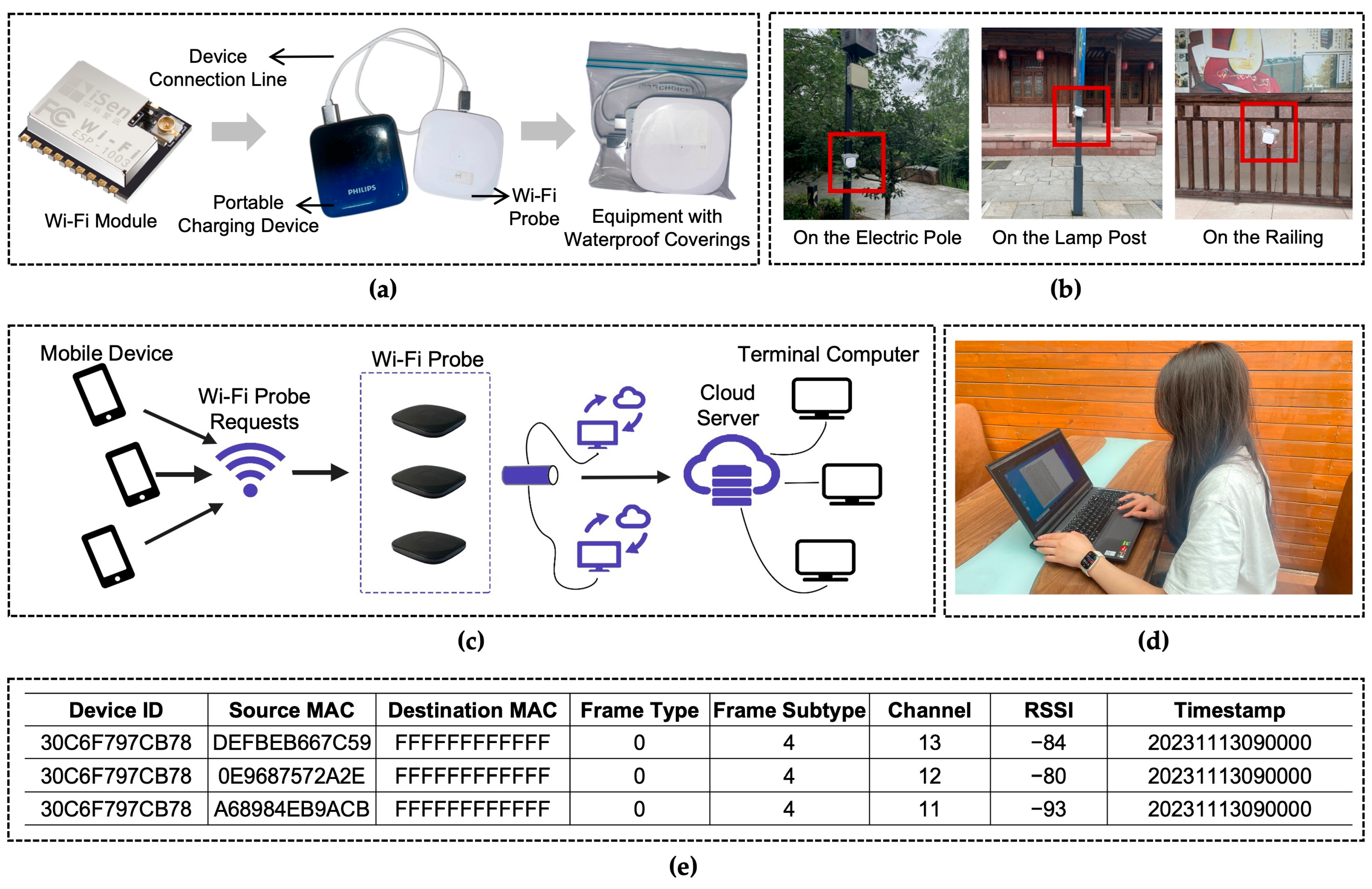
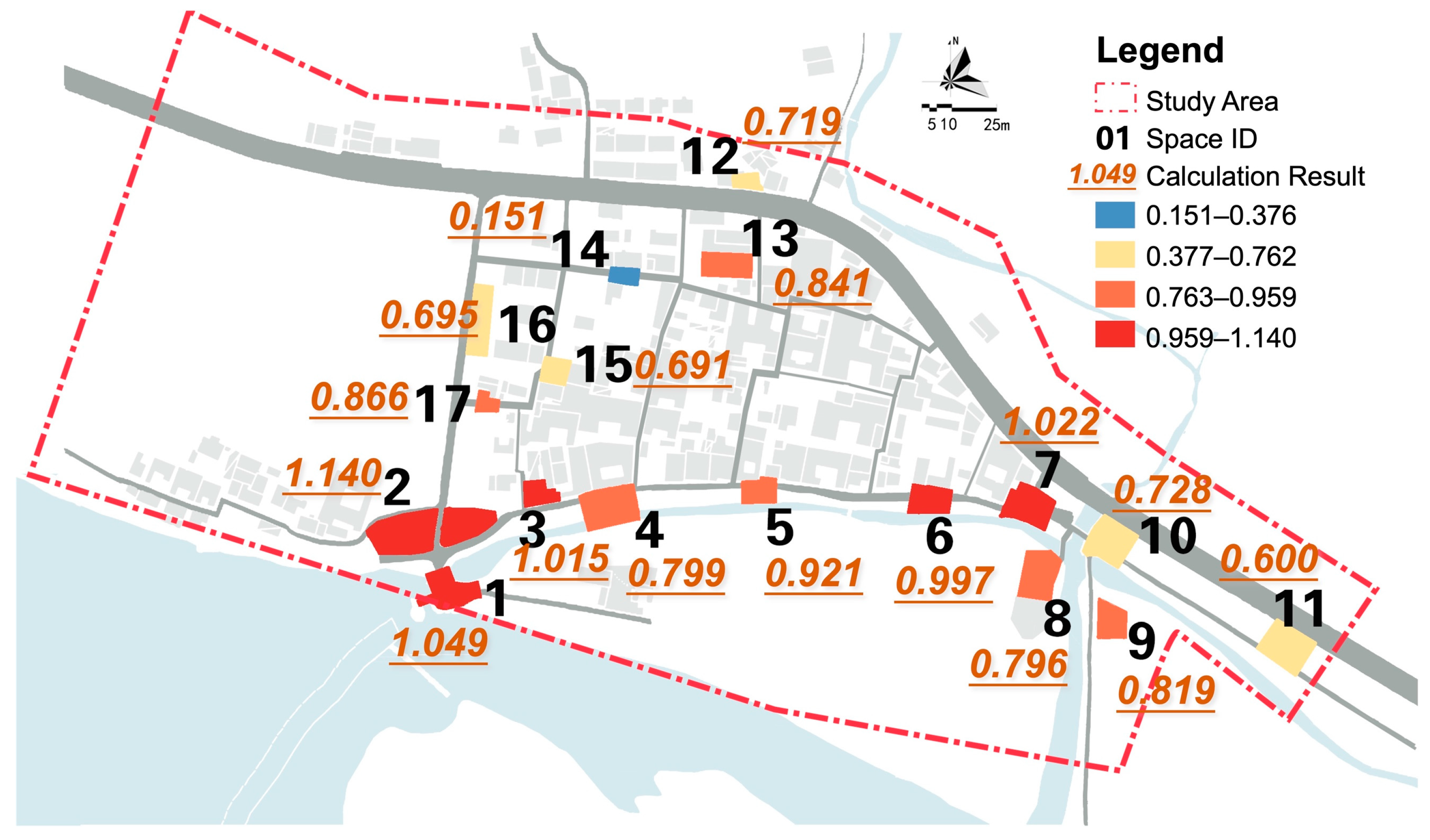
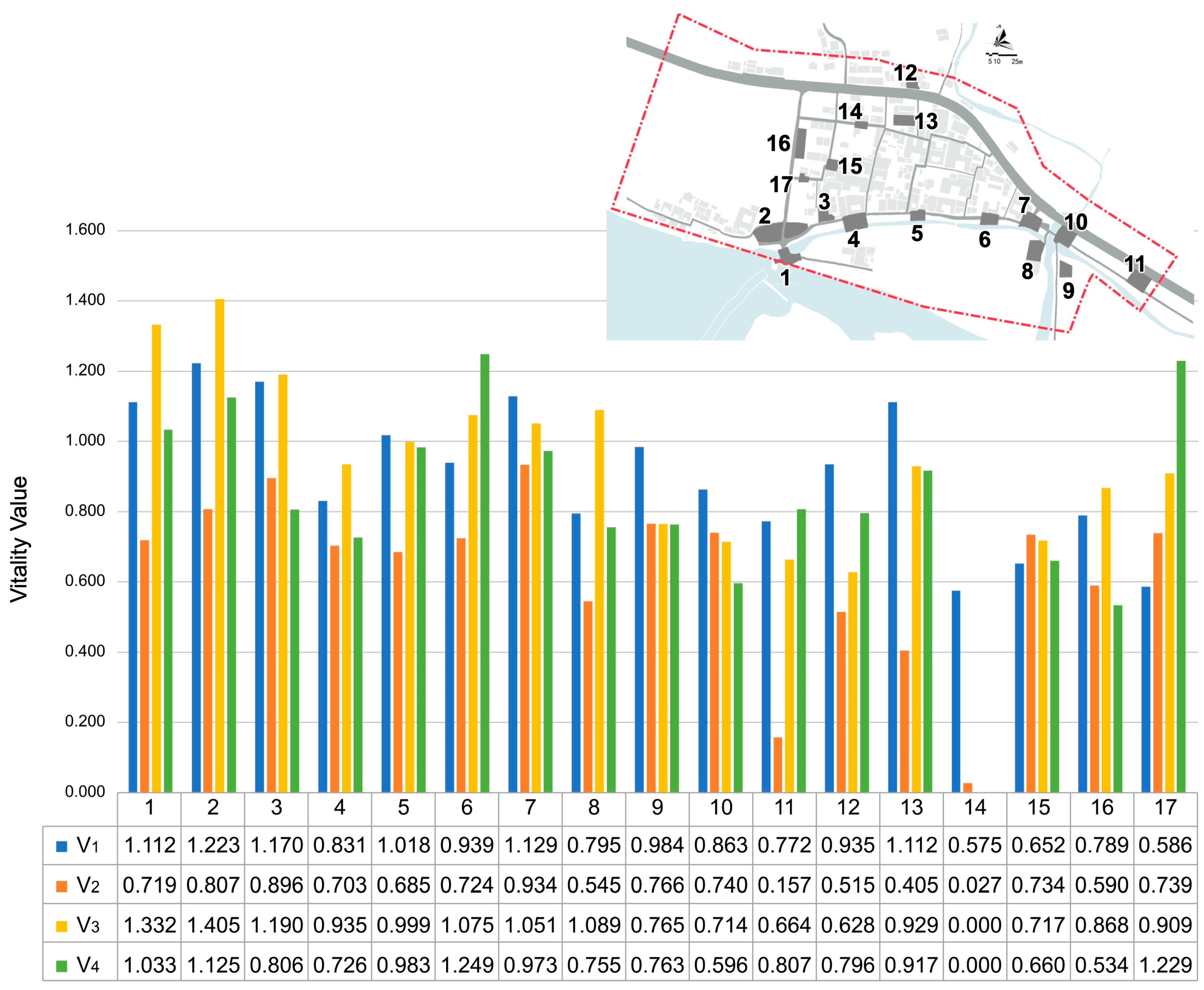
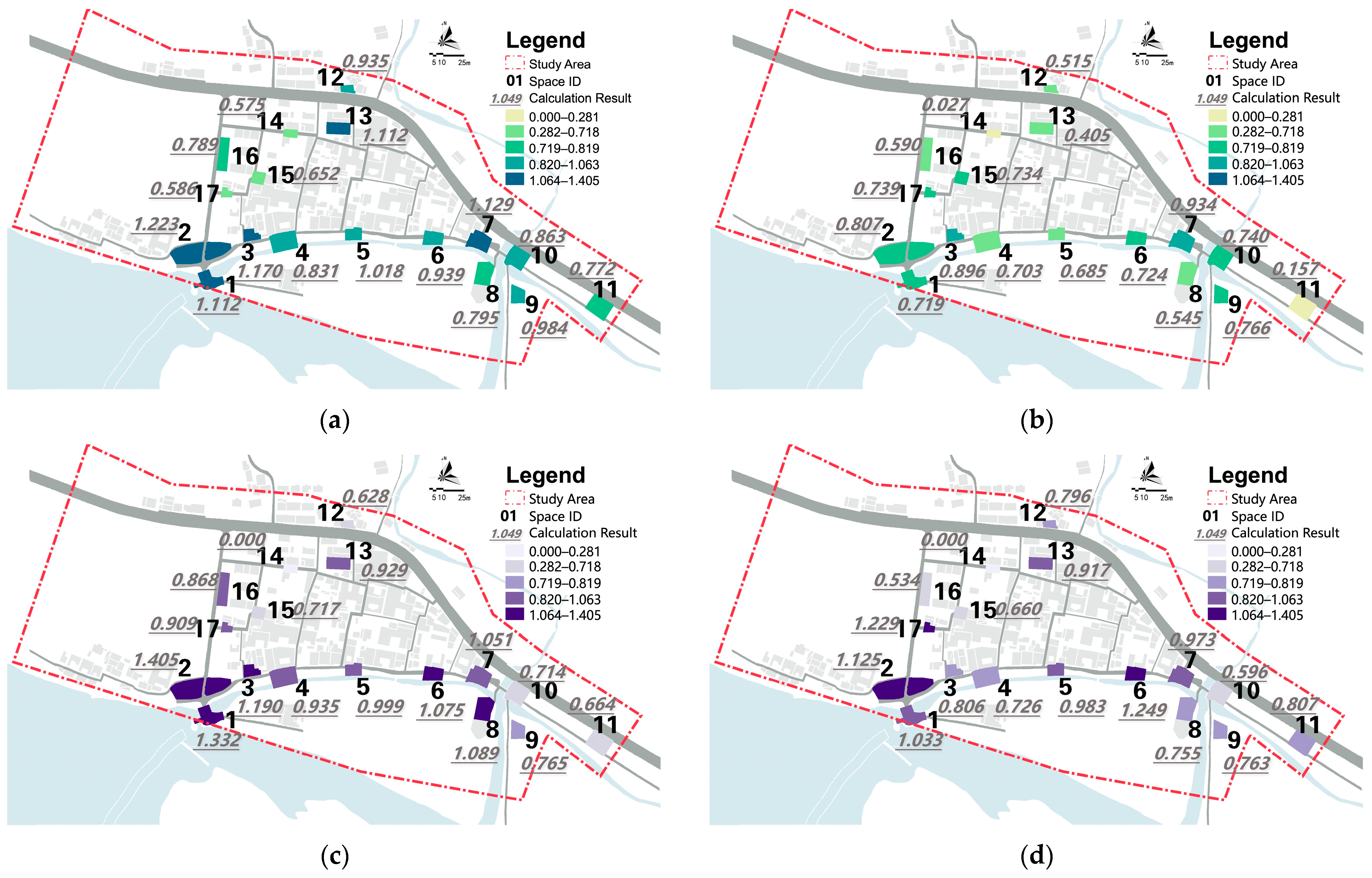
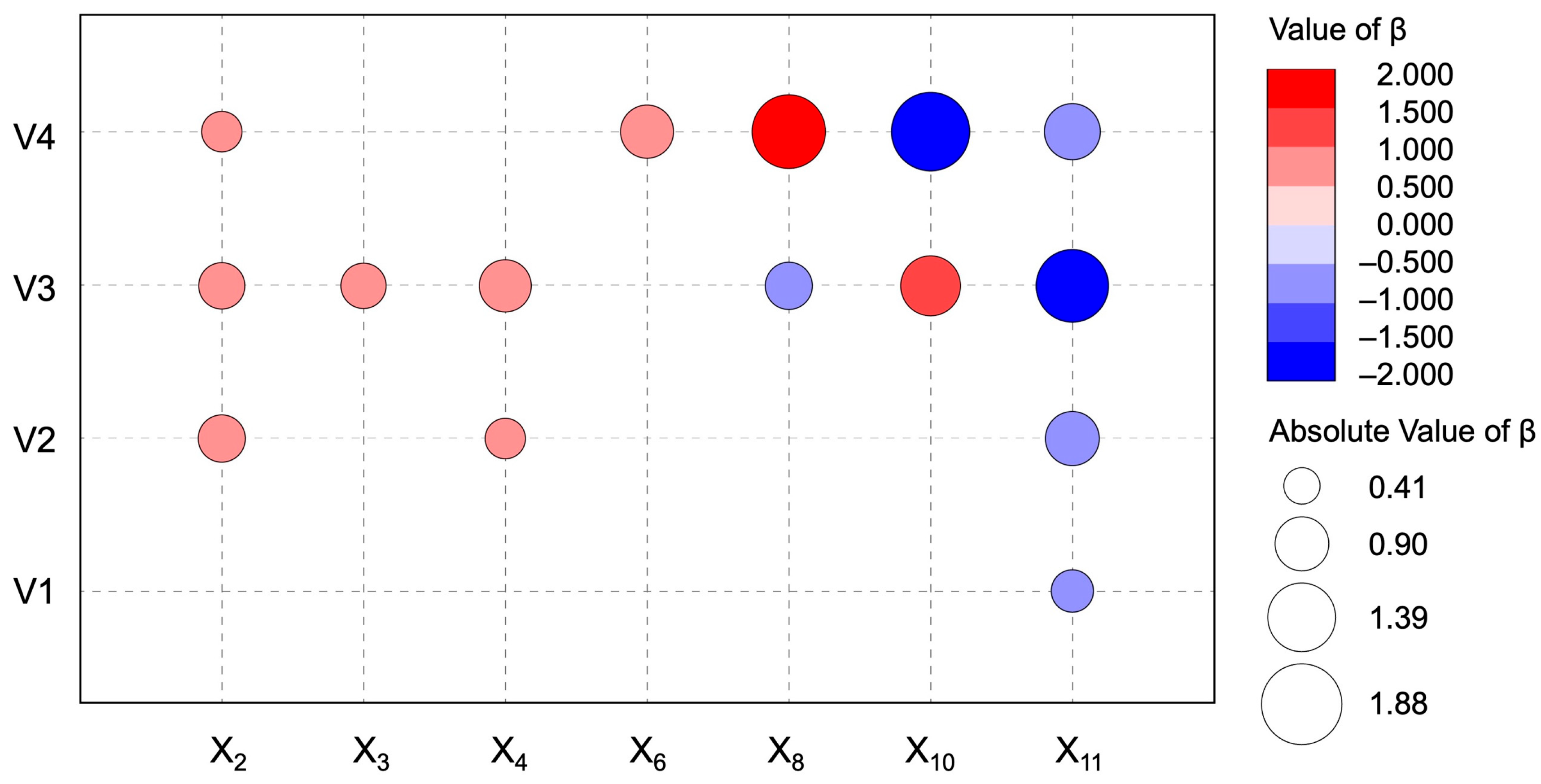
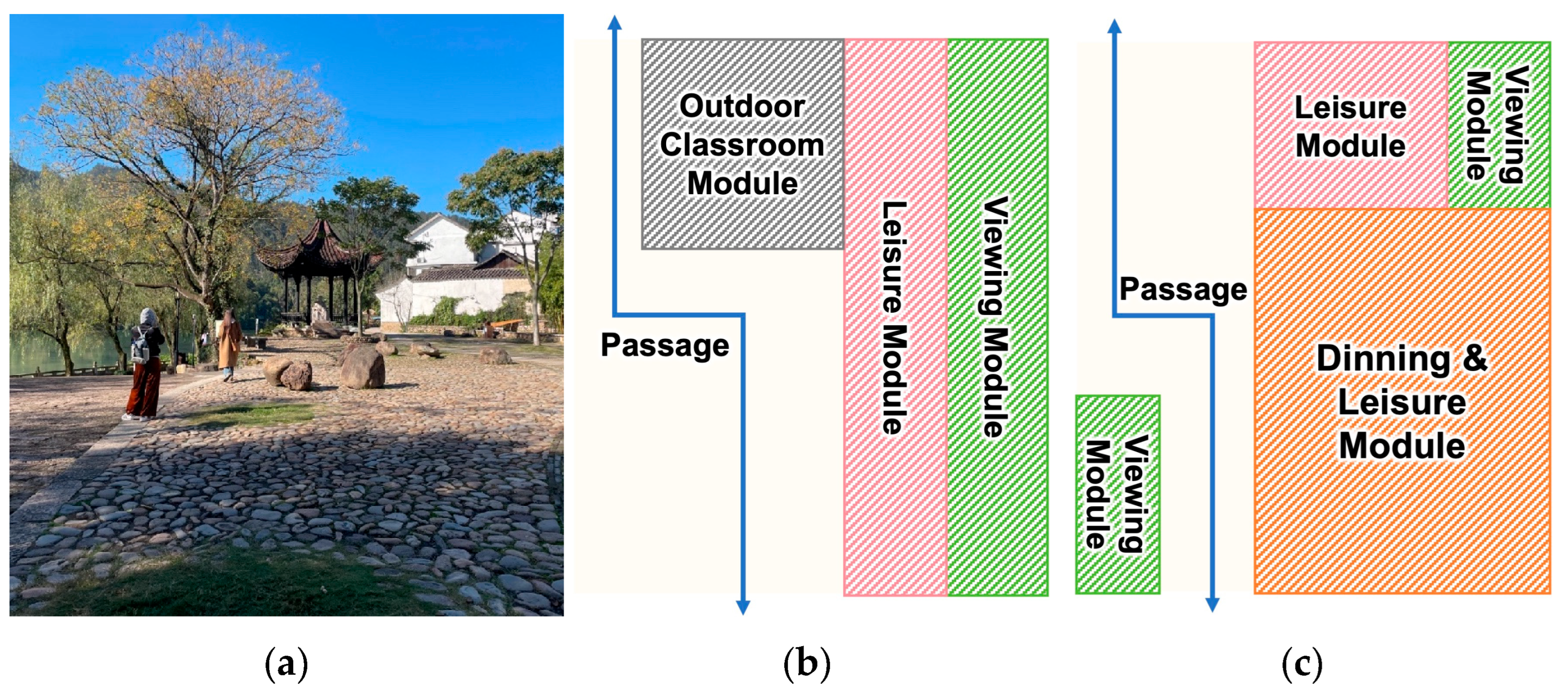
| Dimension | Indicator | Concept | Calculation | Formula | |
|---|---|---|---|---|---|
| Spatial | Retention Intensity (I) | The ability to attract people to visit. | The people flow per square metre per hour. | , | (1) |
| Ii,j: the retention intensity of space j at hour i; Fi,j: the people flow in space j at hour i; Aj: the area of space j. | |||||
| Temporal | Retention Durability (D) | The ability to attract people to stay for a long time. | The average duration of people’s stay. | , | (2) |
| Di,j: the average duration of stay in space j at hour i; tm,i,j: individual m’s single time stay length in space j at hour i; ni,j: the total number of people who stay in space j at hour i. | |||||
| Dimension | Impact Factor 8 | Concept and Calculation | References |
|---|---|---|---|
| Internal | Spatial Scale (X1) | Area of public space. | [68,69] |
| Spatial Accessibility (X2) | Number of paths connected to the public space. | [56,70] | |
| Leisure Facility Count (X3) | Number of leisure facilities within the space 1. | [69,71,72] | |
| Decorative Element Count (X4) | Number of decorative elements within the space 2. | [73] | |
| External | Catering Facility Proximity (X5) | Distance from the space centroid to nearest external catering facility 3. | [68,74] |
| Catering Facility Count (X6) | Number of catering facilities within the public space’s 25 m buffer zone. | [75,76,77] | |
| Retail Facility Proximity (X7) | Distance from the space centroid to nearest external retail facility 4. | [74] | |
| Retail Facility Count (X8) | Number of retail facilities within the public space’s 25 m buffer zone. | [69,77] | |
| Street Vendor Proximity (X9) | Distance from the space centroid to nearest external street vendor 5. | [74] | |
| Street Vendor Count (X10) | Number of street vendors within the public space’s 25 m buffer zone. | [77] | |
| Historical Element Proximity (X11) | Distance from the space centroid to nearest external historical feature 6. | [69,78] | |
| Historical Element Count (X12) | Number of historical features within line-of-sight range. | [75] | |
| Natural Element Proximity (X13) | Distance from space centroid to nearest external natural element 7. | [56] |
| Impact Factor | Vitality Across Typical Time Periods | ||||
|---|---|---|---|---|---|
| V1 | V2 | V3 | V4 | ||
| Spatial Scale (X1) | CC. | 0.338 | 0.115 | 0.397 | 0.103 |
| Sig. | 0.184 | 0.660 | 0.115 | 0.694 | |
| Spatial Accessibility (X2) | CC. | 0.347 | 0.624 ** | 0.457 | 0.454 |
| Sig. | 0.172 | 0.007 | 0.065 | 0.067 | |
| Leisure Facility Count (X3) | CC. | 0.257 | 0.252 | 0.558 * | 0.557 * |
| Sig. | 0.319 | 0.328 | 0.020 | 0.020 | |
| Decorative Element Count (X4) | CC. | 0.257 | 0.589 * | 0.561 * | 0.495 * |
| Sig. | 0.320 | 0.013 | 0.019 | 0.043 | |
| Catering Facility Proximity (X5) | CC. | −0.309 | −0.551 * | −0.576 * | −0.431 |
| Sig. | 0.228 | 0.022 | 0.016 | 0.084 | |
| Catering Facility Count (X6) | CC. | 0.202 | 0.525 * | 0.634 ** | 0.597 * |
| Sig. | 0.437 | 0.030 | 0.006 | 0.011 | |
| Retail Facility Proximity (X7) | CC. | −0.613 ** | −0.240 | −0.547 * | −0.525 * |
| Sig. | 0.009 | 0.353 | 0.023 | 0.031 | |
| Retail Facility Count (X8) | CC. | 0.564 * | 0.013 | 0.431 | 0.382 |
| Sig. | 0.018 | 0.962 | 0.084 | 0.130 | |
| Street Vendor Proximity (X9) | CC. | −0.485 * | −0.662 ** | −0.527 * | −0.380 |
| Sig. | 0.048 | 0.004 | 0.030 | 0.133 | |
| Street Vendor Count (X10) | CC. | 0.567 * | 0.468 | 0.580 * | 0.223 |
| Sig. | 0.018 | 0.058 | 0.015 | 0.390 | |
| Historical Element Proximity (X11) | CC. | −0.370 | −0.380 | −0.654 ** | −0.397 |
| Sig. | 0.144 | 0.133 | 0.004 | 0.115 | |
| Historical Element Count (X12) | CC. | 0.520 * | 0.555 * | 0.761 ** | 0.424 |
| Sig. | 0.033 | 0.021 | 0.000 | 0.090 | |
| Natural Element Proximity (X13) | CC. | −0.330 | −0.361 | −0.481 | −0.370 |
| Sig. | 0.196 | 0.155 | 0.051 | 0.143 | |
| Predictors | Unstandardized Coefficient | Standardized Coefficient | t | p | VIF | Model Diagnostics | |||
|---|---|---|---|---|---|---|---|---|---|
| B | Std. Error | β | R2 | adj R2 | F | ||||
| (Constant) | 1.064 | 0.075 | 14.281 | 0.000 *** | 0.295 | 0.248 | 6.290 (p = 0.024 *) | ||
| Historical Element Proximity (X11) | −0.005 | 0.002 | −0.544 | −2.508 | 0.024 * | 1.000 | |||
| Predictors | Unstandardized Coefficient | Standardized Coefficient | t | p | VIF | Model Diagnostics | |||
|---|---|---|---|---|---|---|---|---|---|
| B | Std. Error | β | R2 | adj R2 | F | ||||
| (Constant) | 0.073 | 0.199 | 0.366 | 0.720 | 0.784 | 0.734 | 15.714 (p = 0.000 ***) | ||
| Spatial Accessibility (X2) | 0.194 | 0.040 | 0.690 | 4.902 | 0.000 *** | 1.190 | |||
| Decorative Element Count (X4) | 0.065 | 0.025 | 0.501 | 2.577 | 0.023 * | 2.278 | |||
| Historical Element Proximity (X11) | −0.010 | 0.002 | −0.904 | −4.919 | 0.000 *** | 2.029 | |||
| Predictors | Unstandardized Coefficient | Standardized Coefficient | t | p | VIF | Model Diagnostics | |||
|---|---|---|---|---|---|---|---|---|---|
| B | Std. Error | β | R2 | adj R2 | F | ||||
| (Constant) | −0.579 | 0.175 | −3.301 | 0.013 * | 0.982 | 0.958 | 41.824 (p = 0.000 ***) | ||
| Spatial Accessibility (X2) | 0.245 | 0.032 | 0.655 | 7.568 | 0.000 *** | 2.870 | |||
| Leisure Facility Count (X3) | 0.045 | 0.005 | 0.632 | 8.226 | 0.000 *** | 2.262 | |||
| Decorative Element Count (X4) | 0.140 | 0.018 | 0.817 | 7.826 | 0.000 *** | 4.177 | |||
| Retail Facility Count (X8) | −0.126 | 0.029 | −0.678 | −4.331 | 0.003 ** | 9.401 | |||
| Street Vendor Proximity (X9) | 0.011 | 0.001 | 0.945 | 7.635 | 0.000 *** | 5.872 | |||
| Street Vendor Count (X10) | 0.101 | 0.018 | 1.098 | 5.483 | 0.001 *** | 15.363 | |||
| Historical Element Proximity (X11) | −0.025 | 0.002 | −1.619 | −13.183 | 0.000 *** | 5.779 | |||
| Predictors | Unstandardized Coefficient | Standardized Coefficient | t | p | VIF | Model Diagnostics | |||
|---|---|---|---|---|---|---|---|---|---|
| B | Std. Error | β | R2 | adj R2 | F | ||||
| (Constant) | 0.543 | 0.232 | − | 2.344 | 0.047 * | − | 0.838 | 0.676 | 5.180 (p = 0.016 *) |
| Spatial Accessibility (X2) | 0.175 | 0.066 | 0.507 | 2.636 | 0.030 * | 1.829 | |||
| Catering Facility Count (X6) | 0.160 | 0.043 | 0.845 | 3.680 | 0.006 ** | 2.606 | |||
| Retail Facility Proximity (X7) | 0.008 | 0.003 | 0.632 | 2.495 | 0.037 * | 3.169 | |||
| Retail Facility Count (X8) | 0.281 | 0.082 | 1.651 | 3.421 | 0.009 ** | 11.513 | |||
| Street Vendor Count (X10) | −0.159 | 0.046 | −1.883 | −3.483 | 0.008 ** | 14.450 | |||
| Historical Element Proximity (X11) | −0.014 | 0.003 | −0.963 | −4.162 | 0.003 ** | 2.646 | |||
Disclaimer/Publisher’s Note: The statements, opinions and data contained in all publications are solely those of the individual author(s) and contributor(s) and not of MDPI and/or the editor(s). MDPI and/or the editor(s) disclaim responsibility for any injury to people or property resulting from any ideas, methods, instructions or products referred to in the content. |
© 2025 by the authors. Published by MDPI on behalf of the International Society for Photogrammetry and Remote Sensing. Licensee MDPI, Basel, Switzerland. This article is an open access article distributed under the terms and conditions of the Creative Commons Attribution (CC BY) license (https://creativecommons.org/licenses/by/4.0/).
Share and Cite
Liu, S.; Zhu, Z.; Gao, Y.; Wang, S.; Zhou, Y. Exploring Factors Behind Weekday and Weekend Variations in Public Space Vitality in Traditional Villages, Using Wi-Fi Sensing Method. ISPRS Int. J. Geo-Inf. 2025, 14, 386. https://doi.org/10.3390/ijgi14100386
Liu S, Zhu Z, Gao Y, Wang S, Zhou Y. Exploring Factors Behind Weekday and Weekend Variations in Public Space Vitality in Traditional Villages, Using Wi-Fi Sensing Method. ISPRS International Journal of Geo-Information. 2025; 14(10):386. https://doi.org/10.3390/ijgi14100386
Chicago/Turabian StyleLiu, Sheng, Zhenni Zhu, Yichen Gao, Shanshan Wang, and Yanchi Zhou. 2025. "Exploring Factors Behind Weekday and Weekend Variations in Public Space Vitality in Traditional Villages, Using Wi-Fi Sensing Method" ISPRS International Journal of Geo-Information 14, no. 10: 386. https://doi.org/10.3390/ijgi14100386
APA StyleLiu, S., Zhu, Z., Gao, Y., Wang, S., & Zhou, Y. (2025). Exploring Factors Behind Weekday and Weekend Variations in Public Space Vitality in Traditional Villages, Using Wi-Fi Sensing Method. ISPRS International Journal of Geo-Information, 14(10), 386. https://doi.org/10.3390/ijgi14100386







